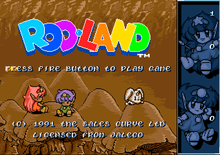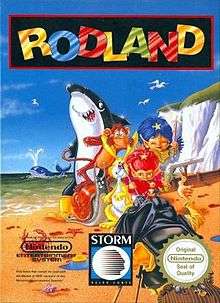Rod Land
| Rod Land | |
|---|---|
 Japanese arcade flyer of Rod Land. | |
| Developer(s) | Jaleco, The Sales Curve, Eurocom |
| Publisher(s) | Jaleco, Storm |
| Platform(s) | Arcade, Amiga, Amstrad CPC, Atari ST, Commodore 64, Game Boy, NES, ZX Spectrum. iOS |
| Release date(s) | April 1990 (ports; some released later) |
| Genre(s) | Platform, Action |
| Mode(s) | Single player, Up to 2 players simultaneously |
Rod Land, known in Japan as Yousei Monogatari Rod Land (妖精物語ロッドランド, lit. "Rod Land: A Fairy Tale") is a 1990 arcade game originally developed and published by Jaleco.
Gameplay

The player(s) control one or two fairies called Tam and Rit armed with a magic wand (rod). Following the concept of Taito's Bubble Bobble, the rod doesn't kill the monsters directly, but only leaves them immobilized, crying. To kill them, the rod can grasp them in a magic force-field and the player can smash them down over her head until they disappear and leave a power-up behind.
Each level is only one small screen composed of monsters, platforms, ladders and, later, tunnels. Unlike other games of the genre, the players can never jump, but have to use ladders. They can conjure one custom ladder above or below them in order to go to the appropriate platform. There can be only one such 'custom' ladder; therefore if the fairy summons it again, it will disappear from its previous position in order to appear again next to the fairy. This can be beneficial for the player, if a monster is climbing that ladder to approach her.

The fairies' quest is to rescue their mother, trapped in a tower. In the sequel (part of the original arcade machine) they must venture into a pyramid, to stop an evil force that is building a mobile fortress. The spirit of their departed father "guides" them at a couple of points. The ending implies that the evil in the pyramid was somehow responsible for their father's death.
Ports and related releases

Originally a coin-op arcade game, it has since been ported to virtually every platform around in the early nineties, the first being the Amstrad CPC version in 1990, the last being the Nintendo Game Boy version in 1993. (This excludes modernized remakes such as the port for Symbian mobiles in 2006.)
The home versions of the game were created by the Sales Curve Ltd from their London based development office. The Amiga and ST versions were coded by Ronald Pieket Weeserik and John Croudy, the Commodore 64 version by Steve Snake, and the NES version by Simon Pick and Steve Snake. The NES version was only released in Italy, Spain, the Netherlands and Japan. The Amiga version was ranked the 16th best game of all time by Amiga Power.[1]
All of these versions differ in some way — particularly the NES version, which adds some new platform stages and allows the player to jump — but by far the biggest difference is that the arcade version includes a totally different 'sequel' (with new graphics, levels, bosses and storyline) on completion of the original game. The enemies in the "second story" are more robotic. This sequel can be accessed directly at the start of the game, if the joystick is moved down three times between inserting a coin and pressing the 1P or 2P button.
In the Game Boy version specifically, the player can strike enemies with the wand even while climbing a ladder, making the game slightly easier to play.
Rod Land was followed by a 1992 puzzle spin-off titled Soldam.
References
- ↑ Amiga Power magazine issue 64, Future Publishing, August 1996
External links
- Arcade version
- Rod Land at the Killer List of Videogames
- Rod Land at arcade-history
- Home versions